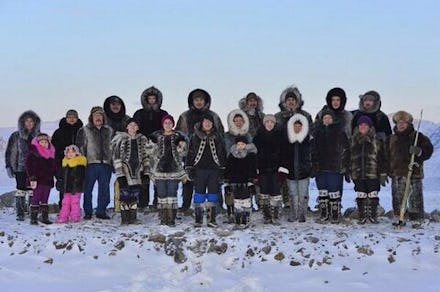These Aboriginal Canadians Are Standing Up to Ellen DeGeneres Using #Sealfies

If you've never heard of a "sealfie," don't be alarmed. Chances are, you've never participated in an Inuit pro-seal hunting campaign in the Arctic.
But that's what's happening in northern Canada right now – and the results are some of the more unexpected responses to the post-Ellen selfie landscape.
For the uninitiated, here's a #sealfie:
It's a photo that generally features an Inuit person or persons wearing items of clothing made of seal fur. The #sealfie hashtag marks it as part of a growing social media trend that's swept the Arctic Circle over the past week:
And of course, this happened too:
The skinny: Its genesis began March 2, when Samsung talked Ellen DeGeneres into taking this now legendary photo and tweeting it to her 28 million-plus Twitter followers during the Academy Awards broadcast:
Aside from drumming up publicity for the Samsung Galaxy Note 3, the picture came with a bonus: For every time the photo was retweeted, Samsung would donate $1 to a charity of Ellen's choosing. When the time came to put up or shut up, the pic had been retweeted 1.5 million times. So Samsung donated $1.5 million to the Humane Society of the United States, an organization that, as a staunch vegan and animal rights supporter, is very close to Ellen's heart.
But it's also one of the most vocal opponents of legal seal hunting in Canada, and successfully pressured the European Union to ban most seal imports. Seals are quite happy about this, presumably. But the Aboriginal tribes of the Canadian Arctic are not impressed.
Backlash began when a 17-year-old Inuit girl — "Inuit" referring to the indigenous groups who populate Canada's northernmost territories — named Killaq Enuaraq-Strauss posted this six-minute video on YouTube:
Oops. Enuaraq-Strauss explains that she's huge fan of Ellen's, but takes issue with her characterizing seal hunting as "one of the most atrocious and inhumane acts against animals allowed by any government."
"We do not hunt seals, or any animal for that matter, for fashion," she says. "We hunt to survive. If Canada were to ban the seal hunt, so many families would suffer, would face harsher forms of malnutrition, and wouldn't be able to afford proper clothing for the Arctic environment we live in. Even more so, another part of our culture would have been killed."
In response, Inuit journalist Leila Beaudoin launched the #sealfie solidarity hashtag that has now amassed many tweets worth of support.
Corporate vs. Culture: The Canadian government allowed 400,000 seal deaths during its annual sponsored hunt in 2012 — a number many argue is unsustainable. Other critics claim the hunt is inhumane and wasteful, in addition to becoming less lucrative every year.
Predictably, the Inuit relationship to seal hunting is quite different. Compared to the 300,000 harp seals the sealing industry kills each spring, the Inuit kill around 1,000 a year, plus about 10,000 ring seals. The Inuit hunt for subsistence and mainly target full-grown animals, whereas the industry habitually kills cubs as young as 12 days old. The number of seals that Inuit people kill for their pelts accounts for just 3% of the total annual number in trade.
So the real problem seems to be the hunt's industrialization. Anti-seal hunting activists say the Canadian government conflates its yearly hunt with the subsistence hunting of indigenous people. Which is absurd: When Canadian Senator Mac Harb suggested that Canadians put more resources into helping Aboriginal communities "market their products" instead of wasting tax payer money outlawing the hunt in 2009, the Inuit weren't having it:
"This is stupid," writes Arnaituk M. Tarkirk, an Inuit man from Quebec. "We are skillful hunters who hunt adult animals for food. That is not the same as bashing a pup, which can't move, over the head. In fact, if the seal hunt stopped, we would benefit the most. There would be 180,000 more seals left for us to eat when they are a few years older, and also people would not have such an aversion to sealskin products as they have after seeing the way they kill the pups, so craft work made with adult seals would be more popular."
So while the government-sponsored hunt is clearly problematic, it's a mistake to lump it together with Inuit subsistence and tradition. And when Ellen had Samsung donate all that money to an organization largely dedicated to eliminating seal hunts, many Inuit saw it as an attack on their culture.
Ellen hasn't shared her thoughts on the #sealfie campaign, but it's hard to imagine she'll be happy with seal killings in any capacity, mass hunt or not. Unfortunately for her, it's not her call: No matter how much she donates, there remain thousands of indigenous people who rely on seal meat and pelts for survival in the frigid North.
It's something people should think about the next time a similar situation arises. And considering the past few centuries of American and Canadian assault against North American indigenous cultures, it's high time to start listening to them anyway.